|
|
Seti I Obelisk (Alexandria)
| Present Site: | Roman Amphitheater, Alexandria, Egypt N 31°11'41.2"(31.194783) E 29°54'12.1"(29.903372) |
| 1. | Pharaoh: | Seti I (New Kingdom 19th Dynasty, Reigned 13 Century BC) |
| Measurement: | About 4 meters high excluding the pedestal | |
| Stone: | Yellow quartzite | |
| 2. | Pharaoh: | Seti I(New Kingdom 19th Dynasty, Reigned 13 Century BC) |
| Measurement: | Fragment. 1.44 meters high | |
| Stone: | Red granite |
About The Site:
These obelisks are standing in the Open Air Museum, located in the western side of Roman Amphitheater, which is one of the points of interest in Alexandria. The Roman Amphitheater was discovered during the excavation in 1960s when a government building was planned for this location over the ruins of a Napoleonic fort that had earlier been destroyed. The Polish Mediteranean Archeological Center, Warsaw University, and the Egyptian Supreme Council of Antiquities formed a joint project team for the excavation, and then the existence of Roman Amphitheater was unclosed. The Roman baths was also found at north of Amphitheater, and the excavation work is still keeping in the northern areas.
The Roman Amphitheater was built in the 4th century. At that time Egypt became a province of the Roman Empire, Alexandria flourished as its center city. The Amphitheater has a diameter of about 33 meters, and the seatings are made surround the center stage. The ruins of the Roman Amphitheater have been found in various places in the area that was the territory of the Roman Empire other than Italy. Among them, this is not so large one, but this remained in use for about 300 years until Alexandria was abandoned after the Islamic invasion. And the conservation status is fairly good.
The Open Air Museum was made in 2005 by the request of Egyptian Supreme Council of Antiquities, and this is just exhibiting the obelisks, sphinx, and stone columns, and so on, which was discovered from the bottom of the sea around the inshore of Alexandria through the French CEAlex (le Centre d'Etudes Alexandrines)'s salvage excavations since 1992.
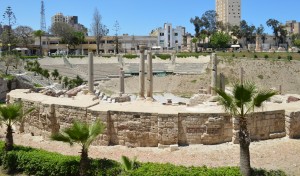 The Amphitheater and the Open Air Museum
The Amphitheater and the Open Air MuseumThe obelisk can be seen in right back |
|
OBELISK OF SETI I On each side of this obelisk of Seti I can be read the three first names of the royal titulary. Reemployed under Ramses II and then removed to Alexandria, it was the object of restorations as can be seen by the numerous fixing slots it bears. The pyramidion was mounted upon a cavity that is still filled with lead. After being dismantled its base was cut up. Two other fragments still under water could be added to this ensemble. OBÉLISQUE DE SÉTHI 1er Sur chaque face de cet obélisque de Séthi 1er se lisent les trois premiers noms de la titulature royale. Usurpé par Ramsès II, puis déplacé jusqu'à Alexandrie, il a subi des restaurations dont témoignent les nombreux scellements qu'il portent; de même, le pyramidion était assemblé grâce à une cavité encore remplie de plomb. Après son démantèlement, sa base a été découpée. Deux autres fragments encore immergés pourraient venir compléter ce montage. OBELISK OF SETI 1 On each side of the obelisk of Seti 1, read the first three names of royal titles. Usurped by Ramses II, then moved to Alexandria, he underwent restorations with many seals that bear witness; likewise, the pyramidion was assembled with an even cavity filled with lead. After its dismantling, its base was cut. Two other still submerged fragments could complement this set. |
How To Get There:
You should walk to the Open Air Museum, because the distance to the entrance of the Museum is only about 200 meters from the Alexandria Main Station of ENR (Egyptian National Railways). In front of the station exit, there is a square, and please proceed to the right side of the square, or the north direction, so you can soon see the ruins of Roman Amphitheater surrounded by a fence. You won't lose the way if you check the Google Maps (above right on this page) in advance. I think about two hours is enough for looking around the Amphitheater and the Open Air Museum.
About The Obelisk:
In this Museum, two obelisks of Seti I (Reigned 13 Century BC), both are the parts of obelisk, are exhibited.
1. Seti I Obelisk (Upper portion and the base stone)
This one is introduced on the CEAlex's website. This was salvaged in 1995, is comprised of four (4) fragments. This was reassembled with the obelisk's main parts made up of three pieces from just under the lost pyramidion and the base stone or the pedestal. Although the current measure of the obelisk itself is about 4 meters, but the whole height is estimated about 8 meters because the lower portion was lost. Also, this is one of th pair obelisks, and another one is said that is still undersea.
This Obelisk, the four corners are largely cut off and has a cylindrical shape. This would be due to the fragile material of quartzite, a kind of metamorphic rock, and the result of this was eroded when lying undersea. For this reason, the inscriptions, only a part can be read. However, the hieroglyph on the base stone remains considerably, we can confirm the coronation name and the birth name of Seti I. It seems to be written on the base stone (pedestal) that this obelisk was dedicated to the Gods of Heliopolis.
In the Open Air Museum, the explanation is written in French, Arabic, and English. I'm attaching here three description texts; English, French, English machine translated by Google from French. According to this, the obelisk was moved to Alexandria by Ramses II.
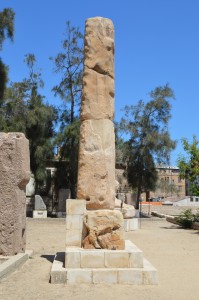
South side |
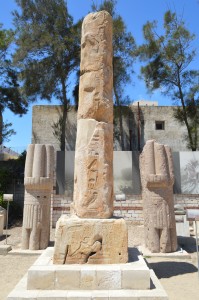 East side |
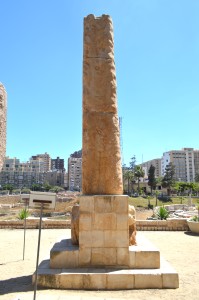 West side |
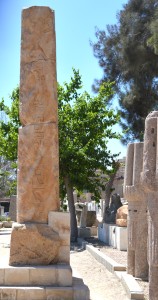 North side |
|||
April 28, 2016 by Hiroyuki Nagase (For high definition image, please click the picture)
| ||||||
2. Seti I Obelisk (Fragment)
Here is an another Seti I Obelisk in this Open Air Museum. This seems to be a fragment of upper portion of the obelisk, because the horus name of Seti I interrupts in the middle. Since its material is red granite, this is obviously not a pair of above mentioned obelisk. The explanation says, the height is 1.44 meters, width is 73 cm X 71 cm, weight is 2.09 tons.
Although the explanation in English language of this obelisk can not be read as it's partially dirty, but the explanation in French can be completely read. I will attach that text and English translation by Google machine translation. According to this explanation, this obelisk was also originally in Heliopolis. A unique illustration is drawn at the top where the king in the form of sphinx is dedicating something to God Ra-Horakhty. Although the pyramidion has been lost, the explanation says there is a notch for attaching the metallic pyramidion.
Since the place of this obelisk is at the corner of the exhibition site, I could take pictures of the front and right sides, but for the left side I could take only from obliquely front, and I was unable to take the back side. (See below)
Notes For Pictures:
I knew the Seti I Obelisk is in the Open Air Museum of Alexandria, but I didn't know where is in Alexandria. Before I go to Alexandria in April 2016, when I was checking the websites on the sightseeing spots of Alexandria, I incidentally noticed the posted picture which shows the site like an open air museum near by the Amphitheater. Then I confirmed this is the site of the Open Air Museum with the enlarged Google Earth image of Amphitheater area.
The ruin of Roman Amphitheater was well maintained, but the Open Air Museum, its entrance and the explanation panels were very old. It seems that it has obviously been left unattended for many years. Some of the explanations of the exhibits were dirty and some were unreadable. The impression of tourists deteriorated due to insufficient maintenance, and consequently the tourists don't come here, then the further maintenance became less - it seemed to be in a vicious circle. This phenomenon can be said in general about every Egyptian historic sites and public facilities. It's very regrettable.
Copyright Hiroyuki Nagase nagase@obelisks.org and Shoji Okamoto okamoto@obelisks.org